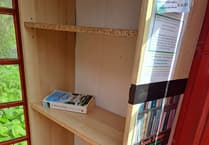Okehampton Town Council has reluctantly resolved to ask the county council to grant the footpath running behind the Old Mill site public right of way status.
The decision comes despite many councillors abstaining from voting, stating safety concerns because the footpath, which is currently closed, runs beside structurally unsafe buildings.
Following the planning officer’s report in April to the borough council, where demolition of the Old Mill ‘eyesore’was denied, it was, however, determined that the end gable of the building was unstable and the adjacent footpath was closed accordingly.
Cllr Jan Goffey said: ‘I am a bit concerned because the footpath was closed because of the danger of the Mill.
‘I can see why it has been suggested but I think it might prove to be a mistake so I am urging caution.’
However, other councillors have supported the idea given that the footpath has been used as an unofficial public right of way for over 20 years.
Cllr Paul Jessop said: ‘I think it’s quite a good idea. Footpaths can be moved anyway. I think it’s a good idea considering it’s been in use for twenty years and it’s had money put into it.’
Over the years, the abandoned Old Mill site has been particularly contentious as many plans for renewing the site have failed to materialise.
Simon Essex, who owns the site, has been attempting to redevelop the site for community purposes for over ten years. Previous schemes have included a community centre for Okehampton College and a small housing development on the site.
Planning permission for four townhouses and 14-16 apartments was submitted in 2019 on the site near Okehampton College, with extra plans in place to save the Grade II listed 19th century factory chimney from the demolition required to build the planned residential buildings.
Most recently, West Devon Borough Council’s development, management and licensing committee failed to approve a planning application put forward by the Okehampton Sports and Skills Trust.
This was despite planning officers’ recommendation to demolish the site and the trust’s work to rehouse the bats that are currently resident in the building.
A new bat house was built to meet planning conditions which require that the bats, which are designated as a protected species, be rehoused before the buildings can be knocked down.
Despite this most recent blow, one of the trustees said that if the footpath were to become a public right of way, the trust would be required to shore up the building.
Christine Marsh said: ‘If it’s a public right of way, you can’t just close it. We would need planning permission to make the buildings safe.’
The pathway, which runs between Mill Road and Park Row, has been used as a public footpath for over 20 years and official public right of way status would protect the right of members of the public to use the walkway.
This would mean that members of the public have a legal right to access the land at any time even though it may be owned by a private individual.





Comments
This article has no comments yet. Be the first to leave a comment.